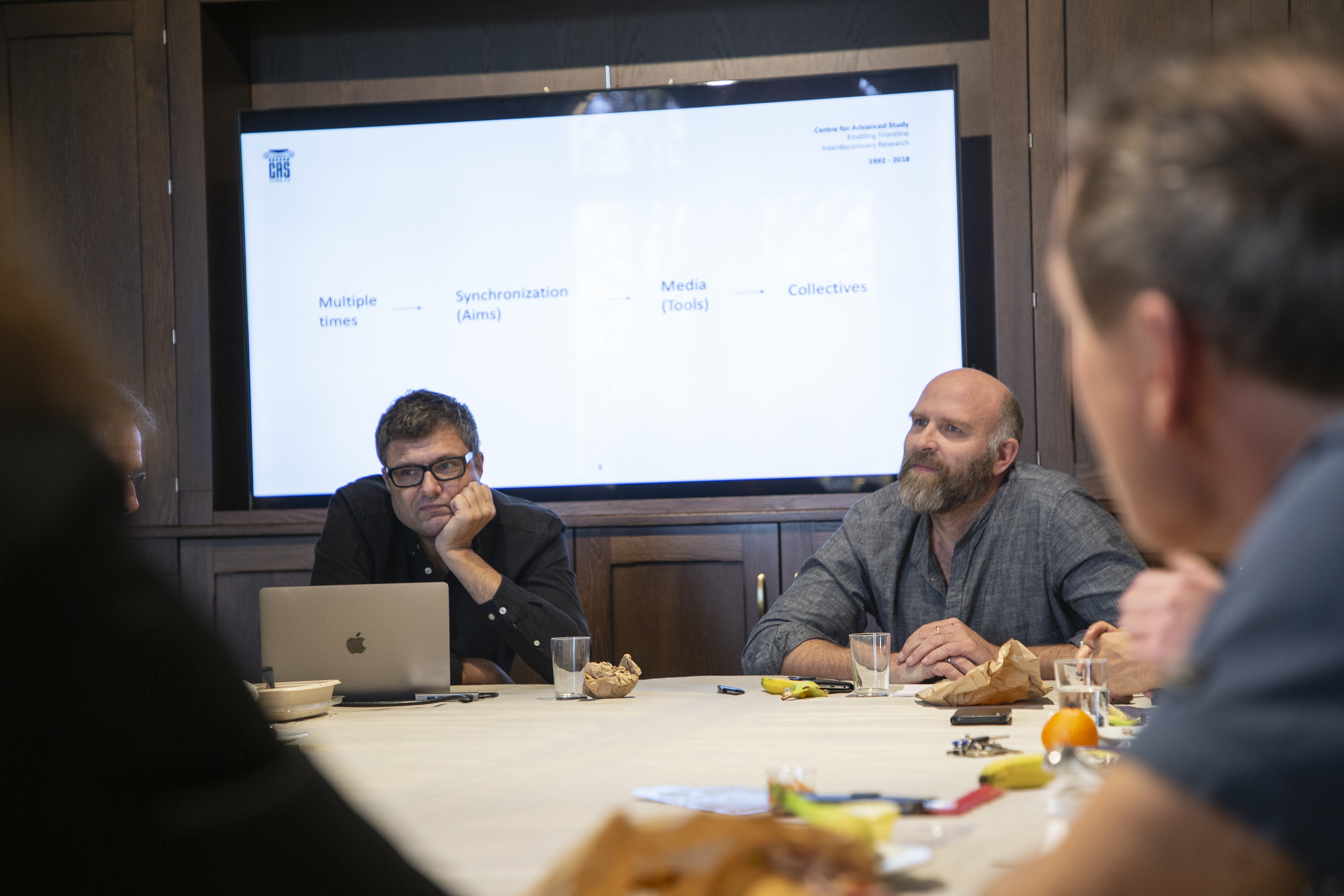Project Update: 'In Sync: How Synchronisation and Mediation Produce Collective Times, Then and Now'

Following a well-deserved winter break, the fellows have returned to CAS to continue their research.
We checked in with the members of the project In Sync: How Synchronisation and Mediation Produce Collective Times, Then and Now to learn how their work is going, their thoughts on the stay so far, and their plans for the spring.
Here’s a recap: In Sync: How Synchronisation and Mediation Produce Collective Times, Then and Now is a project about time, and the idea that different forms of media play an important role in organising our different understandings of time. The project is led by Helge Jordheim and Espen Ytreberg, respectively professors of cultural history and media studies at the University of Oslo (UiO).
One signature feature of the project so far has been FridaySync. Part informal working seminar, part end-of-the-week social gathering, FridaySync brings together fellows, external researchers, and guest speakers from around the world every week. Some seminars feature prepared talks; others, discussion sessions about assigned readings; and others, visits with research groups in Oslo.
‘We structured the project with lots of activity built in to gain lots of new impulses,’ Ytreberg said. ‘We bet on lots of exchanging knowledge, lots of people, lots of ideas.’
One semester into the project, that bet appears to have paid off. Ytreberg said the stay at CAS has so far challenged him to think more interdisciplinarily, while Jordheim said the flurry of activity has done wonders for his own academic writing.
‘Being able to sit here together and have a cohesive conversation for six months (at this point) has been even cooler than I had expected,’ Jordheim said. ‘It’s been enormously useful for me. I know that some of the things I’m writing are in a much better place now than they were thanks to the time I’ve had to think them through.’
The project leaders said the fellows are currently brainstorming ideas for how to combine their diverse expertise into a single publication.
‘What we have discovered is that it would be more interesting and relevant than expected if we did something jointly, but none of us wants to do a edited collection with random articles,’ Jordheim said. ‘So what we’re working hard on right now is finding a format for a publication that maintains this form of cohesion -- that is able to communicate a cohesive picture of what we have been working on.’
Jordheim and Ytreberg said they can also see a small academic community forming in which they and other researchers participate in one another’s projects and generate new ones together. In addition to the CAS project, Jordheim, Ytreberg, and several of the fellows are also participating Jordheim’s five-year Toppforsk project, which runs until 2023, as well as a project led by Einar Wigen, who will join the group as a fellow at the Centre this spring. And more ideas and applications are in the works, the project leaders said.
‘We’ve planned for a great deal of overlap between what we’re doing here and stuff we’ll be doing later,’ Ytreberg said. ‘In many ways we think of this as a process that will continue for several years after this stay. This is one stage in a multistage rocket.’
Read more about the project, In Sync: How Synchronisation and Mediation Produce Collective Times, Then and Now, here.
Several fellows have already concluded their stay at CAS. Here's what some of them them had to say about their time at the Centre:
Richard Ling, Shaw Foundation Professor of Media Technology at Nanyang Technological University:
'I am studying how mobile communication has played into social coordination. The fact that, for the first time in history, we are all individually available to one another means that reliance on older well-established coordination regimes, e.g. clock time, have been challenged. Mobile communication means that we can microcoordinate. More recently messaging apps have expanded this to include group-based coordination. The question is; how has this changed social institutions and social cohesion?'
Stine Alling Jacobsen, Ph.D. candidate at the University of Oslo (UiO):
As a part of the project Lifetimes: A Natural History of the Present, my Ph.D. research is concerned with material, colonial, scientific, and environmental histories of the Ivittuut cryolite mine in South Greenland. I find that CAS is a great space for deep concentration as well as a good place to meet peers and discuss common research interests.
The project is also welcoming new fellows this spring. Here's what some of them have planned for their stay:
Jon Inge Faldalen, lecturer at the University of Oslo (UiO):
'At CAS, I will wrap up two chapters from my upcoming thesis "Still Einstellung: Stillmoving Imagenesis" (2019), where I explore the stillness of moving images (in the Lumières, R. Andersson and J. Benning). I will present work in progress and contribute to the weekly seminar. I am truly honoured to work alongside the distinguished scholars in the In Sync project, and I hope to exit on a higher level of confusion.'
Lucian Hölscher, professor emeritus of history at Ruhr University Bochum:
'Under the title "The Time of History," I study the contributions of temporal tools (expressions of time) to the construction of historical narratives in classical works of history from the 18th century onwards. The aim is threefold: First, to write a history of historiography, in which temporal constructions, among others synchrony and diachrony, are seen as the skeletons of narrative buildings; second, to elaborate a theory of historical times build on a phenomenology of temporal tools; and third, to study the relation of time and social life.'